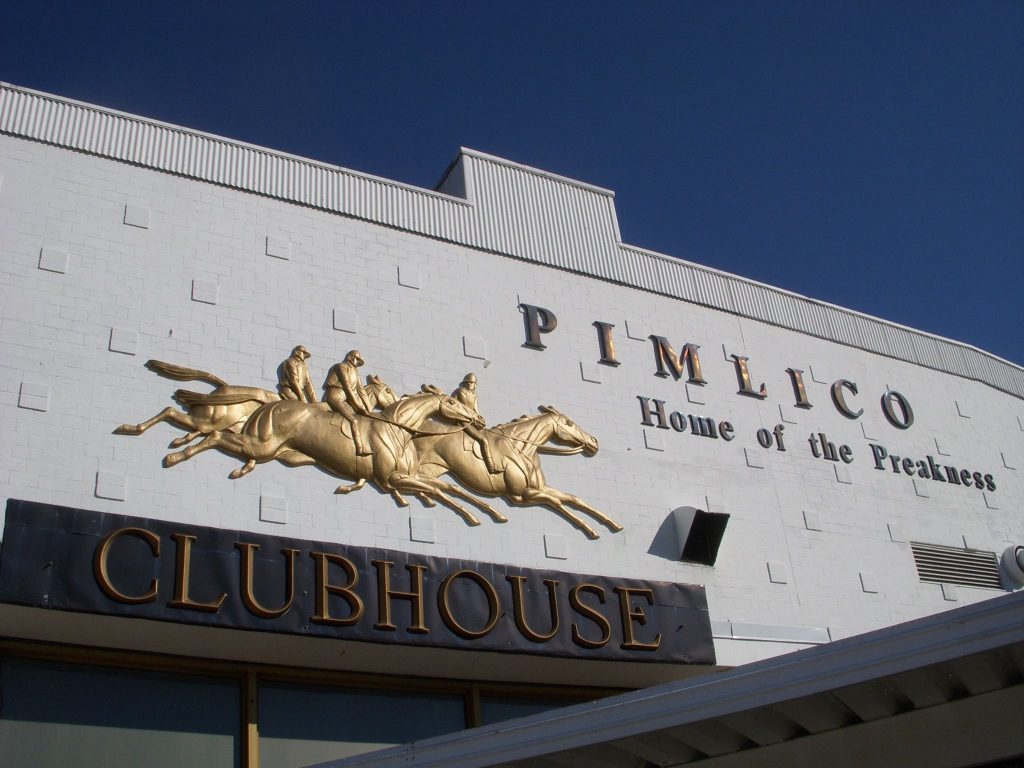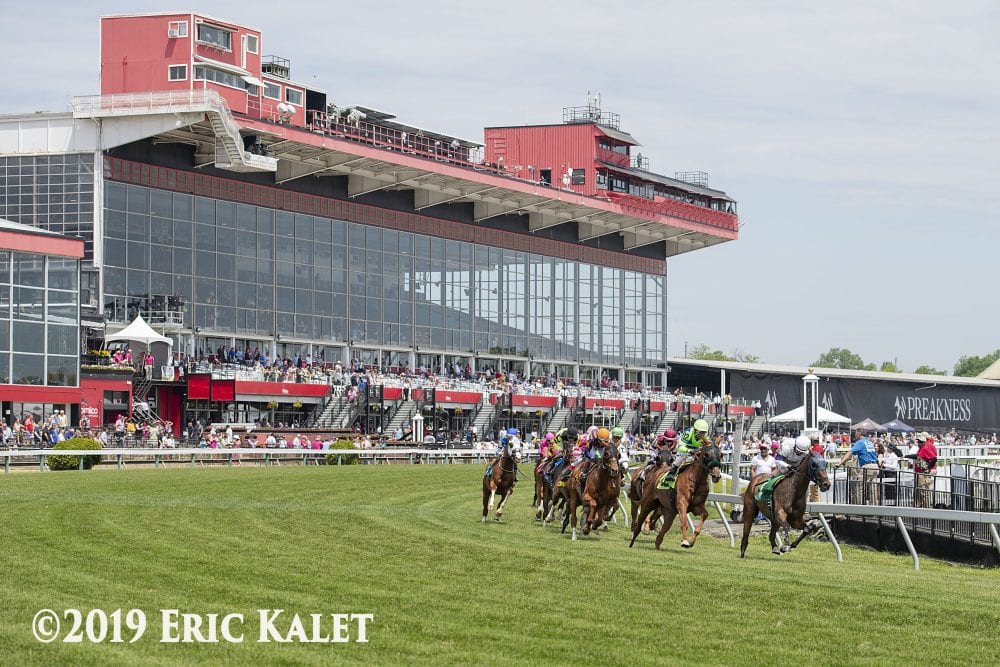
Photo by Eric Kalet
Part I
> History
> Public Bonds
> Owned by a State Entity
> Industry provides revenue, employment, income, and taxes
By Maribeth Kalinich/UPDATED 12/1/2022 3:15 PM
Built in 178 days between the 1959 Spring and Fall meets at a cost of $1.5 million, the Pimlico Race Course clubhouse was a mid-century marvel of design, architecture and engineering.
The large grandstand was built in 1954 also for the cost of $1.5 million and enclosed in glass in 1973.
Both were considered revolutionary for their times with many extended amenities.
And both are standing on steel pilings sunk deep into cement. In the first Maryland Stadium Authority (MSA) Report in 2017 they referred to Pimlico as having what is known as good bones, bad infrastructure. It could be retrofitted.
What is referred to as the old grandstand, the open-air seating, was built in 1922 and altered several times to accommodate the new grandstand. That is going down first. Wait, bonds?
The Cost and Current Plans
Sometime in the near or distant future, historic Pimlico Race Course is earmarked to be leveled to the ground for the cost of $101,302,000. That includes tearing down all of the aforementioned structures plus barns and dorms and any other outbuildings.
This cost also included replacing infrastructure and site work. (Infrastructure was reviewed in the Appendices included with Phase 2 of the MSA Pimlico Study)
All of this will be replaced with a $65,146,000 multi-purpose events center that was presented with an architectural rendering of a glass box. No seating. No grandstand, no clubhouse, no apron. In fact, no horses.
And we don’t know what’s inside the box. Supposedly a museum but there is no illustration or floor plan or dimensions.
The plans for Pimlico only include this structure with additional expenditure of $33,099,000 for infield improvements.
Proposed for the infield were six soccer fields. However, that is still on the table awaiting community input. There’s a proposed picnic area, pond and boardwalk. Also under discussion are track-view dining, pedestrian bridges and additional tunnels to keep visitors from coming in contact with the track.
The design concept by the Ayers Saint Gross architect firm includes rotating the historic track oval by 30 degrees. (A place where people have had their ashes spread.)
“The reason for doing that is … because when you turn the track, (land becomes) available. We build roads around it and get utilities to it. So, it becomes much more desirable parcels for community development,” Glenn Birx, vice president of Ayers Saint Gross told WBAL-TV11.
“Community development” in the form of a parking garage, hotel, grocery store and multi-use housing surrounding the reoriented oval.
The project will take years to complete. According to the MSA, construction (demolition) should begin late summer 2023. The following year, crews will knock down the permanent grandstands. In 2025, crews will tear down the clubhouse. A new clubhouse is expected to be built in 2026, which is also when all the renovations are expected to be completed.
Gary McGuigan, executive vice president of the Maryland Stadium Authority also said to WBAL-TV11: “Pimlico is pretty close to the original concept plan. It hasn’t changed that much.”
Which concept plan?
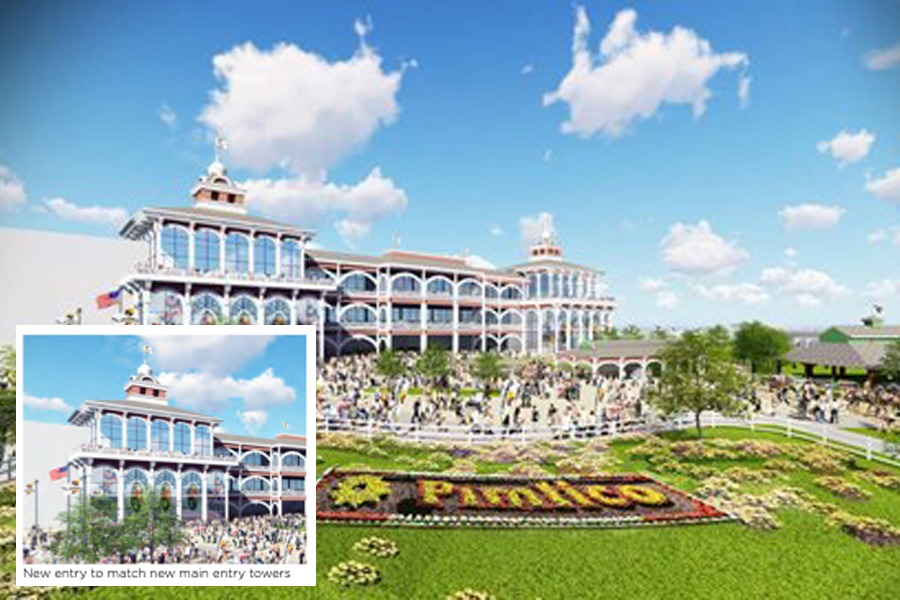
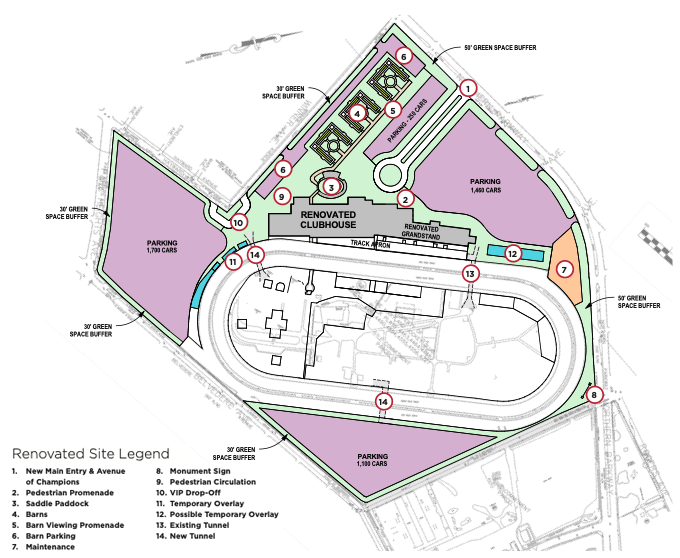
In 2017, MSA released their Phase One of their Pimlico Race Course Study. This was to review the viability of Pimlico, both the facility and location.
They stated the facility could be retrofitted, provided an architectural rendering of the façade fashioned after the Victorian old members clubhouse and included a site plan with barn areas.
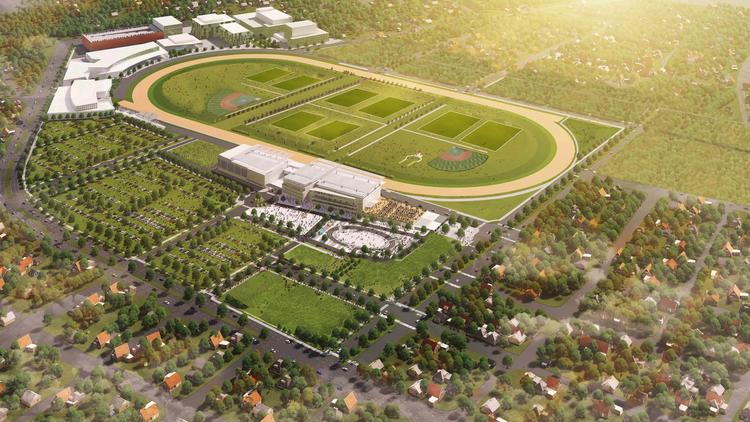
Phase Two of the report was released in 2018. The purpose of this report was said to be how to pay for a renovated Pimlico facility. It was not.
A completely new concept was presented. A pared-down facility with a theme. The clubhouse and plaza area were to be called the Palio — named after the Palio di Siena horse race in Italy. No front elevation rendering was provided.
Notably on the site plan the oval had been relocated.
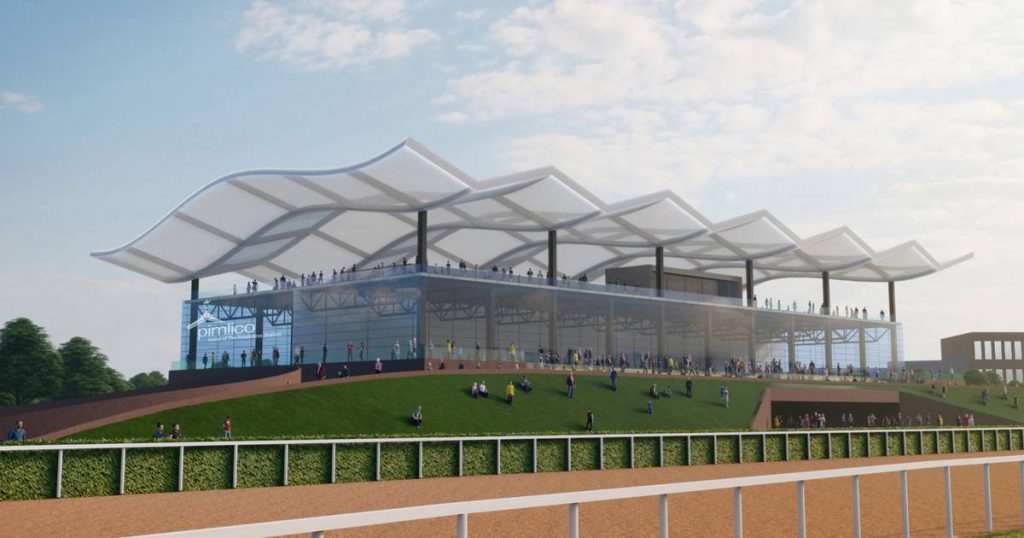
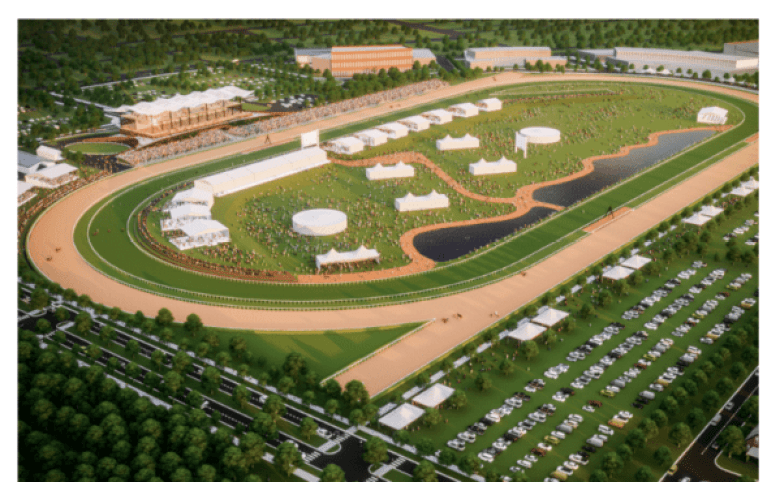
In October of 2019, Maryland Jockey Club held a meeting at Laurel Park to present the new plan to renovate Laurel Park and Pimlico Race Course.
The information offered was the overall cost of the projects, the idea of the bonds to finance the project and a handful of architectural renderings.
Several of the renderings depicted an events center at Pimlico. There was no interior area included.
All barns and Preakness seating will be temporary overlay.
Note on the Capital Investment Plan: Listed are the following:
Existing Source of Funds – Available for Annual Debt Service
• Dedicated Racetrack Capital Improvement Funds (RFRA) $8.5 million
• Horsemen Contribution (Purse Dedication Account) $5 million
• City Infrastructure Contribution (VLT) $3.5 million [racetrack impact fund??]
This is all money from Video Lottery Terminals (VLT) aka slots that will be paid per year for 30 years. $17 million x 30 = $510 million from slots money.
Also included in the Capital Investment Plan is the cash balance in the Capital Improvement Fund (RFRA) of $27.5 million.
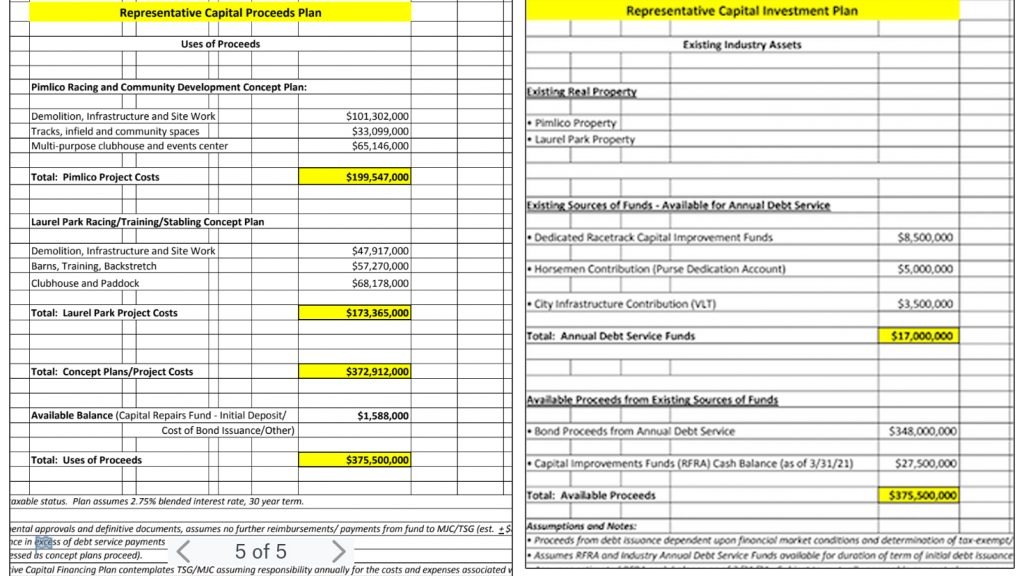
Minor Detalis
In March of 2019, Baltimore Mayor Catherine Pugh et al filed a lawsuit against Maryland Jockey Club to block them from taking the Preakness to Laurel Park. The complaint to take Pimlico Race Course by the City of Baltimore in condemnation and eminent domain also asked the Circuit Court to declare that state law prohibits the Preakness from leaving Pimlico, absent a disaster or emergency. There had been a law on the Maryland books stating the same for decades.
After Mayor Pugh left office over controversy and Jack Young became interim Mayor the suit was dropped in June 2019 and the new plan was created facilitated by the legislature with the passage of SB 987 in April 2020 (without Governor Hogan’s signature).
As it stands, as many as 10 agreements – including transferring the Pimlico property to the City – need to be signed before the Maryland Stadium Authority can sell bonds to finance the project. Community input was supposedly solicited late this past summer.
In April of 2022 the Maryland General Assembly passed HB 897 which included requiring two reports from the Maryland Stadium Authority regarding the progress on Pimlico and Laurel Park Racing Facilities Redevelopment.
The first reports were delivered to the legislature on Sept. 30. The second reports are due January 1, 2023.
The MSA Report gave details about where the Pimlico project stands and the areas of agreement that are still being worked out. To read about the MSA report regarding Pimlico and for a link to the report click here for our story.
Below is a statement issued to Past The Wire by a representative of MSA via email Dec. 1, 2022:
The Maryland Stadium Authority (MSA), as directed by HB 897, Economic Development – Sports Entertainment Facilities and Event, Prince George’s Co. Blue Line Corridor Facilities and Racing Facilities, submitted a preliminary report of the findings from studies of both the Pimlico and Laurel Park racing facilities to the legislature in September 2022, with a final report due in January 2023. Since the report speaks for itself, the MSA has no further comment at this time and respectfully requests Marylanders and those interested in the racing initiatives to refer to the report.
Maryland Stadium Authority Report on the Pimlico and Laurel Park Racing Facilities Redevelopment as Required by HB 897 / Ch. 61, Sec. 3(a), 2022 https://dlslibrary.state.md.us/publications/Exec/MSA/HB897Ch61(3(a))(2022)_2022.pdf
Sometime in December, supposedly December 16, The Stronach Group (TSG), parent company of the Maryland Jockey Club (MJC) will turn over the deed of Pimlico Race Course to the City of Baltimore and they will turn it over to the Maryland Stadium Authority who will facilitate the plan approved by the Maryland General Assembly. But only after they have sold $199, 547,000 in bonds to pay for all of this.
Why is this in play at all? To keep the Preakness Stakes, the second leg of the Triple Crown, the historic American Classics, in Baltimore City. (Caveat: The Stronach Group owns the Maryland Jockey Club which owns the Preakness Stakes. They can take the race anywhere they wish. The penalty would be forfeiting their racing license in Maryland. And defaulting on the bonds.)
The deal is TSG/MJC will lease Pimlico each year for a Preakness meet and pay for the overlay needed (seating, refreshments and accommodations for the horses, etc.) to hold the meet until the bonds are paid off and that will be 30 years or sooner.
What exactly do we get for the $200 million? Actually, a multi-purpose events center on a 20-acre parcel on what was a 110-acres working training center.
The remaining 90 acres of Pimlico will be parceled out and commercially developed. It is unclear if the parcels will be sold or leased.
The Importance of Horses to Pimlico and Horse Racing to Maryland
Currently, Pimlico supports a colony of horses, trainers, outriders, gate workers, pony riders, exercise riders, grooms, barn workers, kitchen staff, maintenance staff, security, and others. This is a 365-day year-round operation. Take away the barns and jobs will be lost.
Yes, they are adding stalls to Laurel Park. Whenever that is completed which is another story for another time. But many employees are from the surrounding community and others won’t be able to make the transition to Laurel.
The Maryland horse racing and breeding industry has a huge impact in Maryland in many ways and if Pimlico ceases to exist as it is now, a year-round training center and a full-service racetrack, that will be compromised.
There are many facets to the industry including Thoroughbred racing. In total, the horse industry brings to Maryland a $2.1 billion economic impact with $78 million in tax revenues, 28,000 jobs and $1 billion spent by participants.
With an economic impact of $270 million, the competition sector of sport horses supports 3,346 jobs and adds $162 million in value to the state economy. Recently, Fair Hill hosted the internationally acclaimed Maryland Five Star Eventing competition for the third straight year which brought in even more to the state.
There are recreation and equine therapy sectors that also add $250 million in economic value.
The Thoroughbred racing industry itself adds $365 million in value to the state economy. The racing sectors have an economic impact of $572 million (Thoroughbred-flat, Standardbred-harness and jump racing).
One race horse on the track supports at least 5,214 jobs: The owner, bloodstock agent, breeders, auction house and employees, hotwalkers, groom, exercise rider, blacksmith, veterinarian, jockey, jockey agent, jockey valet, trainer, and various employees of the assorted businesses.
The industry employs feed and bedding dealers and producers as the industry spends $80,000,000 on feed hay and straw.
Also, the horse creates jobs and the very existence for the racing facility. Tote tellers, food service, security, maintenance, parking, in addition to management positions.
The horse also facilitates such positions as racing secretary and the reason for the Maryland Racing Commission to exist.
Current statistics show there are 10.5 horses per each square mile in Maryland, more than in any other state. There are approximately 101,457 horses in Maryland. 16,000 horse farms and stables with 40 breeds including the Thoroughbred handling 35 different disciplines including flat racing.
The horse industry holds 705,000 acres of greenspace, 25% of Maryland’s agricultural land, 10% of the land in the state. Pastures are among the best filtering devices to protect the Chesapeake Bay from harmful runoff.
200 equine organizations statewide reflect that 51.8% of households in Maryland have horse enthusiasts. 10,000 youths are served by Maryland Education Programs, there are 1,500 4H projects, 765 licensed riding and boarding stables, 55 high school interscholastic riding teams, 22 pony clubs and 12 college equine teams and clubs.
Centuries of History
Then there is the history of the track and horse racing in Maryland.
The Maryland Jockey Club is the oldest sporting organization in America. Thoroughbred horse racing and breeding was prominent in Maryland in early America and many prominent stallions and broodmares came through this state.
Opening in 1870, Pimlico is considered the second oldest racetrack in North America behind Saratoga although there were other tracks before the two including Central Race Course in Baltimore.
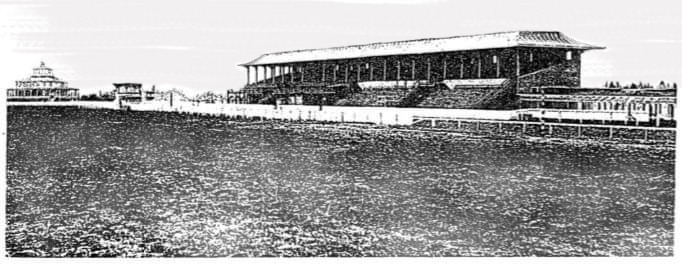
The greatest match race of the 19th century was held at Pimlico. The Great Baltimore Stakes of 1877 between what was considered the western champ, Parole and the eastern champs Tom Ochiltree, 1975 Preakness winner, and Ten Broeck.
The only day in the history of the United States Congress that the House and Senate adjourned together so they could board a chartered train to Pimlico this important race.
There is a bas relief installed in homage to the three horses adoring the large white wall of the clubhouse sculpted by notable artist Bernard Zuckerman. Fashioned after a Currier & Ives print commemorating the race, it was commissioned sometime in 1960 by (we think) the Cohen’s. It’s literally irreplaceable.
Considered by some to be the greatest match race ever in America, the match race between Seabiscuit and War Admiral was held at Pimlico November 1, 1938.
The first tote board in the infield—Pimlico.
As Gilbert Sandler said in his 1955 article in the Sun, “On the chilly afternoon of Oct. 22, 1933, something highly unusual was going on at Old Hilltop. It was a Sunday — at that time, not a racing date at Pimlico Race Course. Yet more than 7,000 fans filled the stands. No horses would race that day, but it was still a historic day.
“What was going on? This: The Maryland Jockey Club had invited Baltimoreans to watch the first East Coast test of the totalizator or “tote” — a revolutionary innovation that racing officials described as “the new betting machine that flashes official odds and total amount of money wagered in electric lights every 60 seconds.”
So famous was this tote board they sold images of this on postcards.
The first electric starting gate on the east coast—Pimlico. After the first electric start in the U.S. took place at Bay Meadows in San Mateo, Calif., in the fall of 1939, and Puett shipped a gate east to be displayed at Pimlico. In 1940 the Preakness Stakes became the first Triple Crown event to use the gates.
The first television broadcast in Maryland on Oct. 30, 1947 came from – you guessed it – Pimlico Race Course. The announcers for races six and seven were two Sun sports reporters named Jim McManus (later McKay) and Joseph B. Kelly.
History isn’t tangible but you can feel the essence of it when you are there. Yes, over the years the track has been neglected. It does not have the glitz of Saratoga or Keeneland. The last major upgrade was when Frank De Francis added the Sports Palace in the 1987. (Now that’s glitz!)
At one time Maryland had 11 mile- and half-mile racetracks. Now there are two.
In closing …
In 2013, everyone in the horse industry made a deal—the 10-year deal—to put money into Pimlico. In fact, Pimlico was made a priority. No one stuck to the deal. Pimlico fell further into decline.
The next part of this story will include what Pimlico could be if there is a different vision for the new plan. Also, what artifacts and treasures reside at the facility that need to be protected and conserved.



